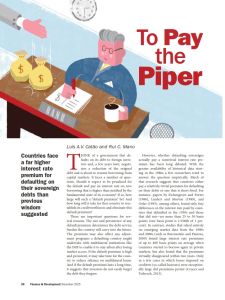Join getAbstract to access the summary!

Join getAbstract to access the summary!
Luis A.V. Catão and Rui C. Mano
To Pay the Piper
IMF, 2015
What's inside?
Countries that default on their sovereign debt pay for it for a long time.
Recommendation
When individuals don’t pay their debts, they usually must pay high interest rates on any future loan, if they can get one at all. But do countries that default face similar penalties when they negotiate a debt reduction and resume borrowing a few years later? This question is an important one, because elevated borrowing costs over an extended period of time could make future debt service burdens unmanageable. This original research from International Monetary Fund economists Luis A.V. Catão and Rui C. Mano offers conclusive evidence of the long-term punishing effects of sovereign debt default. getAbstract recommends it to policy makers and investors.
Summary
About the Authors
Luis A.V. Catão is a senior economist at the International Monetary Fund, where Rui C. Mano is an economist.

















Comment on this summary